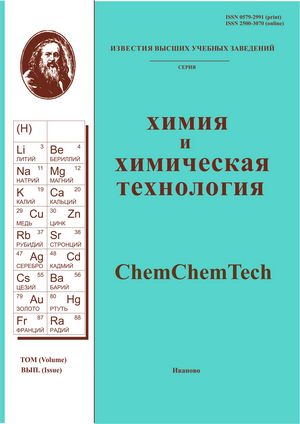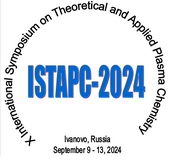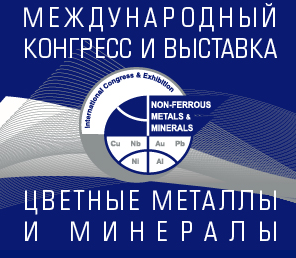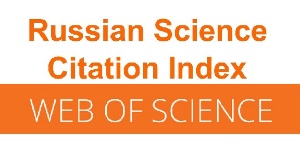ВЛИЯНИЕ ГИДРОФОБИЗАТОРА НА СВОЙСТВА ЭКСПЕРИМЕНТАЛЬНЫХ БЕНТОНИТ-СОДЕРЖАЩИХ БИПОЛЯРНЫХ МЕМБРАН
Аннотация
Получены экспериментальные образцы биполярных ионообменных мембран, изготовленных путем нанесения на анионообменную мембрану-подложку с четвертичными аммониевыми группами МА-41 жидкого сульфокатионообменника ЛФ-4СК, содержащего бентонитовые глины, обработанные стеариновой кислотой. Изучено влияние количества вносимого бентонита (1, 2, 3% по мас.) на характеристики мембран. Входящие в состав бентонита кремниевые и гидроксильные группы ускоряют диссоциацию молекул воды, а значит, увеличивают концентрацию водородных и гидроксильных ионов при проведении биполярного электродиализа. Поверхностное модифицирование частиц бентонита стеариновой кислотой улучшает диспергирование глины в растворе полимера. Проведено сравнение физико-механических характеристик экспериментальных ионообменных мембран, содержащих бентонит, обработанный стеариновой кислотой, с мембраной, содержащей природный необработанный бентонит. Определены полная обменная емкость, плотность, влагоемкость, а также прочность на разрыв и относительное удлинение. Введение гидрофобизатора в мембрану приводит к уменьшению влагосодержания, росту полной обменной емкости и плотности катионообменного слоя по сравнению с мембраной, содержащей бентонит в исходном виде. Проведена конверсия сульфата натрия (концентрация 0,5 моль/дм3) с экспериментальными биполярными ионообменными мембранами. Применение биполярной мембраны, содержащей в катионообменном слое бентонит, обработанный стеариновой кислотой (3%), приводит к увеличению производительности процесса и снижению энергетических затрат по сравнению с промышленно выпускаемой гетерогенной ионообменной мембраной с аналогичными функциональными группами и не содержащей каталитические добавки. Предложена схема получения экспериментальных биполярных мембран, состоящая из стадий: подготовка бентонита; обработка бентонита стеариновой кислотой; подготовка анионообменной мембраны-подложки МА-41; нанесение катионообменного слоя на мембрану-подложку.
Для цитирования:
Нифталиев С.И., Козадерова О.А., Ким К.Б., Белоусов П.Е., Тимкова А.В. Влияние гидрофобизатора на свойства экспериментальных бентонит-содержащих биполярных мембран. Изв. вузов. Химия и хим. технология. 2022. Т. 65. Вып. 10. С. 120-127. DOI: 10.6060/ivkkt.20226510.6686.
Литература
Kozaderova O.A., Niftaliev S.I., Kim K.B. Application of bipolar membranes mb-2 modified by chromium (III) hydroxide for sodium sulfate conversion process. ChemChemTech [Izv. Vyssh. Uchebn. Zaved. Khim. Khim. Tekhnol.]. 2019. V. 62. N 3. P. 30-36 (in Russian). DOI: 10.6060/ivkkt201962fp.5811.
Niftaliev S.I., Kozaderova O.A., Kim K.B. Application of Bipolar Electrodialysis with Modified Membranes for the Purification of Chromic Wastewater from Galvanic Production. Ekologiya Prom. Rossii. 2021. V. 25. N 10. P. 4-9 (in Russian). DOI: 10.18412/1816-0395-2021-10-4-9.
Eswaraswamy B., Mandal P., Goel P., Chandra A., Chattopadhyay S. Intricacies of caustic production from industrial green liquor using bipolar membrane electrodialysis. J. Environ. Chem. Eng. 2022. V. 10. N 3. P. 107628–107839. DOI: 10.1016/j.jece.2022.107628.
Sun Y., Wang Y., Peng Z., Liu Y. Treatment of high salinity sulfanilic acid wastewater by bipolar membrane electrodialysis. Separat. Purificat. Technol. 2022. V. 281. N 15. P. 119842. DOI: 10.1016/j.seppur.2021.119842.
Xia C., Xinyu R., Kentish S., Li G., Tongwen X., George C. Production of Lithium Hydroxide by Electrodialysis with Bipolar Membranes. Separat. Purificat. Technol. 2021. V. 274. P. 119026. DOI: 10.1016/j.seppur.2021.119026.
Shel'deshov N.V., ZabolockiyV.I., Ganych V.V. The effect of insoluble metal hydroxides on the rate of water dissociation reaction on the cation-exchange membrane. El-ektrokhimiya. 1994. V. 30. N 12. P. 1458–1461 (in Russian).
Mel'nikov S.S., Shapovalova O.V., Shel'deshov N.V., Zabolotskiy V.I. The influence of hydroxides of d-metals on the dissociation of water in bipolar membranes. Mem-brany Membrane. Tekhnol. 2011. V. 1. N 2. P. 149-156 (in Russian).
Shel'deshov N.V., Zabolotskiy V.I., Alpatova N.V. The influence of heavy metal hydroxides on the dissociation of water in a bipolar membrane. Nauch. Zhurn. KubGAU. 2015. V. 114. N 10. P. 1-13 (in Russian).
Xue Y.H., Fu R.Q., Fu Y. Xun, Xu T.W. Fundamental studies on the intermediate layer of a bipolar membrane. V. Effect of silver halide and its dope in gelatin on water dissociation at the interface of a bipolar membrane. J. Colloid Interface Sci. 2006. V. 298. P. 313-320. DOI: 10.1016/j.jcis.2005.11.049.
Simons R. Water splitting in ion exchange membranes. Electrochim. Acta. 1985. V. 30. N 3. P. 275-282. DOI: 10.1016/0013-4686(85)80184-5.
Peng F., Peng Sh., Huang Ch, Xu T. Modifying bipolar membranes with palygorskite and FeCl3. J. Membrane Sci. 2008. V. 322. P. 122–127. DOI: 10.1016/j.memsci.2008.05.027.
Liu Y., Chen J., Chen R., Zhou T., Ke C., Chen X. Effects of multi-walled carbon nanotubes on bipolar membrane properties. Mater. Chem. Phys. 2018. V. 203. P. 259-265. DOI: 10.1016/j.matchemphys.2017.09.068.
Martínez R.J., Farrell J. Water splitting activity of oxygen-containing groups in graphene oxide catalyst in bipolar membranes. Comput. Theor. Chem. 2019. V. 1164. P. 112556. DOI: 10.1016/j.comptc.2019.112556.
Manohar M., Das A.K., Shahi V.K. Efficient bipolar membrane with functionalized graphene oxide interfacial layer for water splitting and converting salt into acid/base by electrodialysis. Ind. Eng. Chem. Res. 2018. V. 57. P. 1129-1136. DOI: 10.1021/acs.iecr.7b03885.
Kozaderova O.A. Electrochemical characterization of an MB-2 bipolar membrane modified by nanosized chromium(III) hydroxide. Nanotechnol. Russia. 2018. V. 13. P. 508-515. DOI: 10.1134/S1995078018050075.
Kang M. S., Choi Y., Lee H., Moon S. Effects of inorganic substances on water splitting in ion-exchange membranes; I. Electrochemical characteristics of ion-exchange membranes coated with iron hydroxide/oxide and silica sol. J. Colloid Interface Sci. 2003. V. 273. N 2. P. 523-532. DOI: 10.1016/j.jcis.2004.01.050.
Kang M. S., Choi Y., Moon S. Effects of inorganic substances on water splitting in ion-exchange membranes. II. Optimal contents of inorganic substances in preparing bipolar membranes. J. Colloid Interface Sci. 2004. V. 273. P. 533–539. DOI: 10.1016/j.jcis.2004.01.051.
Abd El-Hakim A.A., Badran A.S., Essawy H.A. The Effect of Surface Treatment of Bentonite on the Mechanical Properties of Polypropylene–Bentonite Composites. Polymer-Plastics Technol. Eng. 2004. V. 43. P. 555-569. DOI: 10.1081/PPT-120029980.
Othman N., Ismail H., Mariatti M. Effect of compatibilisers on mechanical and thermal properties of bentonite filled polypropylene composites. Polym. Degrad. Stabil. 2006. V. 91. N 8. P. 1761-1774. DOI: 10.1016/J.POLYMDEGRADSTAB.2005.11.022.
Mihajlović Slavica R., Vučinić Dušica R., Sekulić Živko T., Milićević Sonja Z., Kolonja Božo M. Mechanism of stearic acid adsorption to calcite. Powder Technol. 2013. V. 245. P. 208-216. DOI: 10.1016/j.powtec.2013.04.041.
Patti A., Hubert L., Anatoli S., Domenico A., Cassagnau P. The universal usefulness of stearic acid as surface modifier: applications to the polymer formulations and composite processing. J. Indust. Eng. Chem. 2021. V. 96. DOI: 10.1016/j.jiec.2021.01.024.
Rothon R.N. Particulate fillers for polymers. Rapra Tech-nology Ltd. 2008. 560 p.
Gonzalez L., Lozano-Ramirez T., Morales-Cepeda A.B. Mechanical and Thermal Properties of Polypropylene/ Montmorillonite Nanocomposites Using Stearic Acid as Both an Interface and a Clay Surface Modifier. Polym. Compos. 2014. V. 35 (1). DOI: 10.1002/pc.22627.
Morales-Cepeda A.B., Lozano-Ramirez T., Navarro-Pardo F., Lafleur P.G. Mechanical and rheological proper-ties of polypropylene/bentonite composites with stearic acid as an interface modifier. J. Appl. Polym. Sci. 2015. V. 132. DOI: 10.1002/app.42264.
Peregudov Yu.S., Niftaliev S.I., Korchagin V.I., Lygina L.V., Bogunov S.I., Malyavina Yu.M. Enthalpy of interac-tion of hydrophobic chalk with water. ChemChemTech [Izv. Vyssh. Uchebn. Zaved. Khim. Khim. Tekhnol.]. 2012. V. 55. N 5. P. 42-44 (in Russian).
Gou J., Zhang L., Li C. A new method combining modification of montmorillonite and crystal regulation to enhance the mechanical properties of polypropylene. Polymer Testing. 2020. V. 82. P. 106236. DOI: 10.1016/j.polymertesting.2019.106236.
Demirbas A., Sari A., Isildak O. Adsorption thermodynamics of stearic acid onto bentonite. J. Hazard. Mat. 2006. V. 135. P. 226-331. DOI: 10.1016/j.jhazmat.2005.11.056.
Hernandez Y., Lozano T., Morales A. B, Navarro-Pardo F., Lafleur P.G., Sanchez-Valdes S., Martinez-Colunga G., Morales-Zamudio L., Lira-Gomez P. Improvement of toughness properties of polypropylene filled with nanoben-tonite using stearic acid as interface modifier. J. Compos. Mater. 2016. V. 51 (3). P. 373 – 380. DOI: 10.1177/0021998316644852.
Nguyen T.T., Nguyen V.K., Pham T.T.H., Pham T.T., Nguyen T.D. Effects of Surface Modification with Stearic Acid on the Dispersion of Some Inorganic Fillers in PE Matrix. J. Compos. Sci. 2021. V. 5. N 270. DOI: 10.3390/jcs5100270.
Eteläaho P., Haveri S., Järvelä P. Comparison of the morphology and mechanical properties of unmodified and surface-modified nanosized calcium carbonate in a polypropylene matrix. Polym. Compos. 2011. V. 32. P. 464-471. DOI: 10.1002/pc.21065.
Kononenko N.A., Demina O.A., Loza N.V. Membrane electrochemistry. Krasnodar: Izd. Kuban. gos. univ. 2017. 290 p. (in Russian).
АО «МЕGА», http://www.mpline.ru/oborudovanie/mem-brany (in Russian).



















